The Strange Tale of Outer Baldonia
A fisherman and his island micro-nation
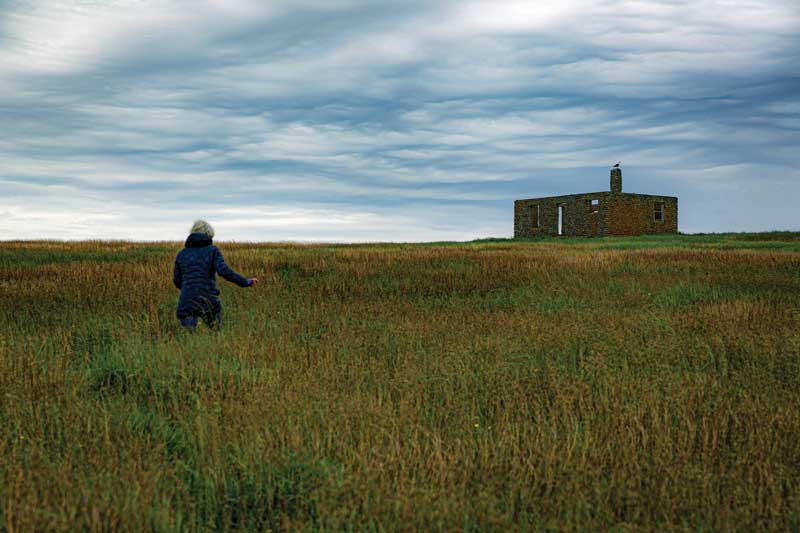 Among the first family members ever to disembark on her grandfather Russell Arundel’s tiny island nation, the author, Wendy Arundel ploughs through tall grass once mowed by sheep to reach the island’s lone cottage. She thought the seagull perched on the chimney might be her grandfather reincarnated. Photo by Sally Arundel DeWees
Among the first family members ever to disembark on her grandfather Russell Arundel’s tiny island nation, the author, Wendy Arundel ploughs through tall grass once mowed by sheep to reach the island’s lone cottage. She thought the seagull perched on the chimney might be her grandfather reincarnated. Photo by Sally Arundel DeWees
Conflicts between the United States and Russia take up many headlines these days, mostly involving big-time global disputes. But back in the 1950s, a small island off the coast of Canada had a brief moment in international news reports thanks to a Washington, D.C., businessman with a sense of humor and a deep love of sport fishing.
He was my grandfather, Russell M. Arundel. It all began when he was fishing in 1948 off a rugged four-acre island in Nova Scotia. He took stock of the place: rocky shore, mewing gulls, a few hardy sheep, untamed beach grass, and a location smack dab in the middle of the greatest tuna hole he had ever known, and he bought the tiny dot at the outer edge of the Tusket Islands for $750 U.S. currency.
Perhaps his initial intent was to use the island for a small fishing camp. But back in Washington, D.C., glass of whisky in hand, he hatched something more elaborate. His first order of business was to change its name from Outer Bald Tusket to The Principality of Outer Baldonia. His ensuing antics, involving regal titles and a “war” against Russia made him a minor-league legend at the height of the Cold War.
After declaring himself the Prince of Princes, Arundel lorded over a population of legitimate and wanna-be fishermen. He built a one-room stone cottage from beach rocks on the island, but spent only one uncomfortable night there, blaming the mosquitoes and relentless cold wind.
His actions even made it into a 1967 Sports Illustrated article. Titled Outer Baldonia Struggles For Its Fishy Place as a Somewhat Emergent Nation and written by Nancy C. Coe, the article played on Arundel’s dry humor in creating a principality and his version of a fisherman’s utopia.
Arundel’s Declaration of Independence was a classic example.
“Fishermen are a race alone,” he wrote, adding that fishermen in his principality “are endowed with the following inalienable rights: The right of freedom from question, nagging, shaving, interruption, women, taxes, politics, war, monologues, cant, and inhibitions. The right to applause, vanity, flattery, praise, and self-inflation. The right to swear, lie, drink, gamble, and silence. The right to be noisy, boisterous, quiet, pensive, expansive, and hilarious. The right to sleep all day and stay up all night.”
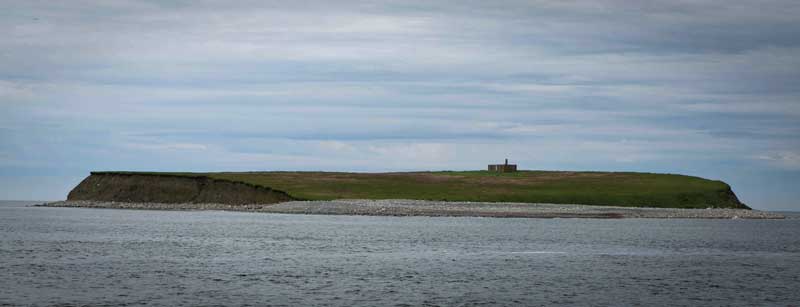 Russell Arundel spent only one night on the island, which he considered inhospitably cold and windy. The southernmost in the Tusket Island chain, it is located eight nautical miles off the Nova Scotia coast. Photo by Sally Arundel DeWees
Russell Arundel spent only one night on the island, which he considered inhospitably cold and windy. The southernmost in the Tusket Island chain, it is located eight nautical miles off the Nova Scotia coast. Photo by Sally Arundel DeWees
Arundel died in 1978. You’d think, considering the family connection, that my siblings, cousins, and I might have had more than an inkling of our “royal heritage.” But to us, Outer Baldonia’s Prince of Princes was just “CayCay,” the other grandparent half to “Khaki”, or Marjorie, as his wife was known to the broader world. We knew CayCay to be quiet and watchful. He smoked a pipe, owned a dachshund named Elmer, and we weren’t to interrupt when he was watching Walter Cronkite. We loved him because, without fail, Cracker Jacks magically appeared from his back pocket when we grandchildren were around.
His daughter, my Aunt Jocelyn, said she, my father, and my grandmother were with him on his first visit to Wedgeport, Nova Scotia, for a tuna fishing tournament. “We were awakened at 4 a.m. and hustled to the docks to board one of the region’s classic tuna fishing boats, and then, as the sun rose, to ride the massive swells of the powerful tides, while a wiry watchful boat captain perched astern with incredible balance,” she recalled.
Arundel loved fishing, she said, but the wild beauty of the Bay of Fundy was equally alluring.
“Through it all, perhaps above it all, my Dad was a champion of the out-of-doors and nature in all its moods,” Aunt Jocelyn said. “He was the first up on those mornings. It may have been June, but I remember it as being very dark and cold, and the little wooden fishing boats as having very hard seats as we headed directly into the huge mountainous rollers of waves.”
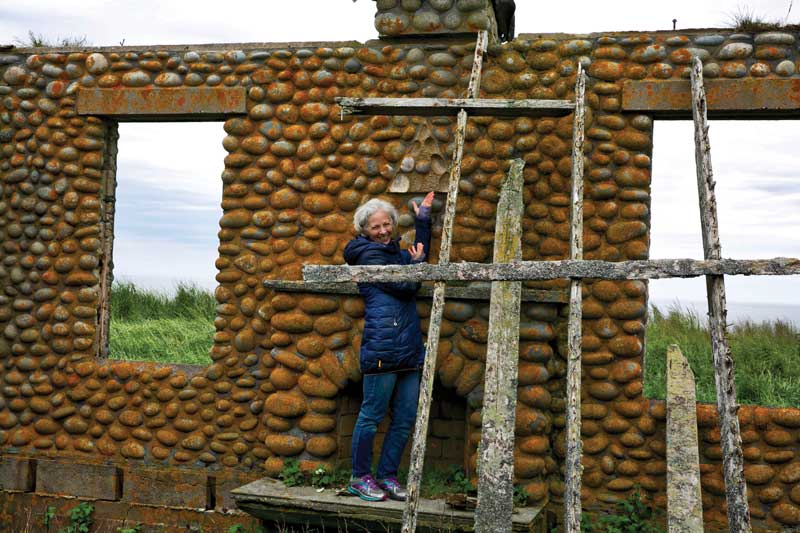 The 30 foot by 20 foot stone building that Russell Arundel had built using beach stone has started to fall down. The author (Arundel’s granddaughter Wendy Arundel) found the remnants of an “A” inlaid above the lichen-covered stones of the fireplace. Photo by Sally Arundel DeWees
The 30 foot by 20 foot stone building that Russell Arundel had built using beach stone has started to fall down. The author (Arundel’s granddaughter Wendy Arundel) found the remnants of an “A” inlaid above the lichen-covered stones of the fireplace. Photo by Sally Arundel DeWees
Arundel was a small man, maybe 5'7" (or maybe not quite) but what he lacked in height he made up for with a different kind of stature. My grandmother—“Dynamite” he called her—wrote that he possessed “winning charm, chiseled features, and bright cheeks. To resemble a Norman crusader, he only needed chain mail. Generous, and outrageously impulsive, his balance from the first was a deadly run for objectives.”
Arundel also possessed an active imagination. With island in hand, fishing buddies in tow, and drinks on tap, the tomfoolery blew up like a pufferfish. To further legitimize his fishy nation, he printed stationery with a gold leaf-embossed Great Seal of Outer Baldonia, featuring, what else—tuna tail, rod, and reel.
Arundel, who was the chairman of the Pepsi-Cola Bottling Company of Long Island, New York, listed his office phone in Washington, D.C., under the name “Outer Baldonia, Principality of,” and his secretary was soon fielding invitations from foreign embassies. Friends who passed a fishing test were given titles like Knights of the Order of Blue Fin and Hereditary Princes of the Realm. Some were made Honorary Admirals. Arundel considered his fishing boat part of the “Outer Baldonia Navy.”
Still nation-building, he persuaded a friend at Rand McNally to include this tiny dot on the outer edge of the Tusket Islands on at least one published map. Soon he and his fishing friends had drawn up laws, named quite a few princes, created a legation in Washington, a flag, and a currency called the Tunar. If that wasn’t frivolous enough, with his friend Arde Bulova, founder of the watch company of the same name (the two had worked together on a secret project during WWII), Arundel designed an 18-karat gold pendant watch with the Outer Baldonia seal, and gifted them to family and special friends.
But hijinks and hilarity aside, what really put Outer Baldonia on the map was Russia’s beef with Arundel’s ideology. Canadian newspapers had written tongue-in-cheek articles about the principality, but someone in Moscow didn’t get the joke. Or maybe they were just playing along.
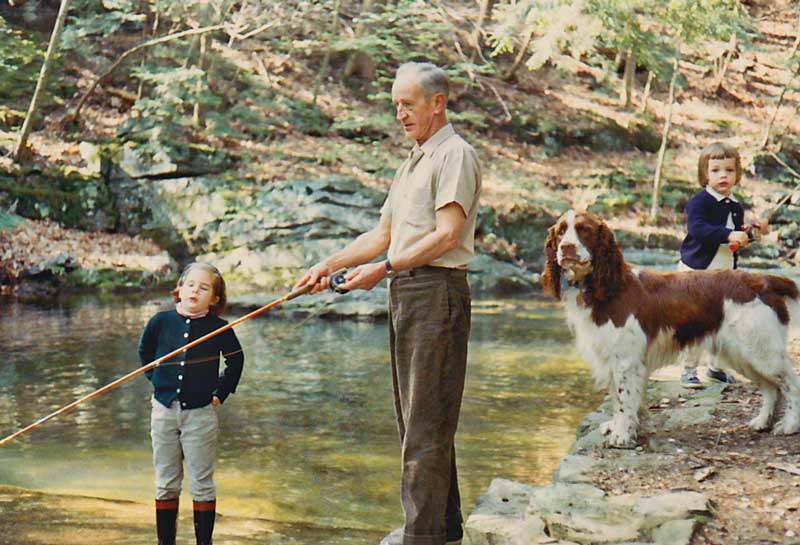 An outdoorsman since childhood, Russell Arundel enjoyed fishing trips as an escape from society and his work in Washington, D.C. He is shown here in 1965 teaching his granddaughters, Sally (left) and Wendy (right), about trout fishing. Image courtesy Wendy Arundel
An outdoorsman since childhood, Russell Arundel enjoyed fishing trips as an escape from society and his work in Washington, D.C. He is shown here in 1965 teaching his granddaughters, Sally (left) and Wendy (right), about trout fishing. Image courtesy Wendy Arundel
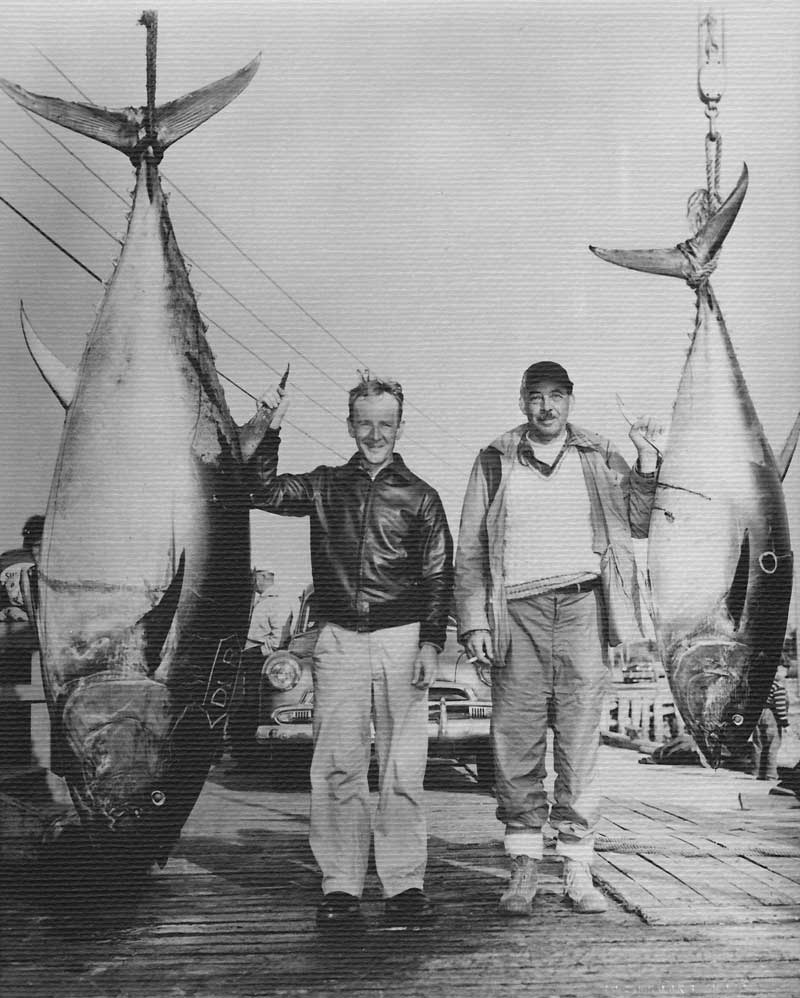 In the mid-1900s, Wedgeport, Nova Scotia was considered the sport tuna fishing capital of the world. It was while fishing for tuna there that Russell Arundel decided to buy Outer Bald Tusket. Here on the left, his brother, Earle Arundel, one of Outer Baldonia’s “princes,” poses with a tuna caught there in the 1950s. When Russell granted the island to the Nova Scotia Bird Society, he asked that it be designated the Earle E. Arundel Breeding Bird Sanctuary. Image courtesy Wendy Arundel
In the mid-1900s, Wedgeport, Nova Scotia was considered the sport tuna fishing capital of the world. It was while fishing for tuna there that Russell Arundel decided to buy Outer Bald Tusket. Here on the left, his brother, Earle Arundel, one of Outer Baldonia’s “princes,” poses with a tuna caught there in the 1950s. When Russell granted the island to the Nova Scotia Bird Society, he asked that it be designated the Earle E. Arundel Breeding Bird Sanctuary. Image courtesy Wendy Arundel
A letter in the Russian magazine, Liternaya Gazeta, in 1952, interpreted the language in the principality’s constitution about the right to “swear, lie, drink, gamble” literally. The writer called Arundel a tyrant, whose aim was to make savages of his subjects by giving them the right to ignore “ethical and moral laws established by mankind.”
Feigning offense, Arundel wrote to Russian leaders, threatening to sever ties with that country unless the magazine apologized. He also asked that Russia keep its fishing trawlers out of Baldonia’s waters. A rod-and-reel guy, he massively disapproved of their fishing practices involving nets and electroshocking. The “Prince” considered the tuna swimming near his island to be the Outer Baldonia Coast Guard, and as such, said they were under his protection. His proclamations were backed by the Halifax Yacht Club, Wedgeport fishermen, and their combined yachts and boats.
 Every country flies a flag, apparently even a four-acre micronation; this banner was found amongst family treasures inherited by Russell Arundel’s daughter, Jocelyn. Image courtesy Arundel family
Every country flies a flag, apparently even a four-acre micronation; this banner was found amongst family treasures inherited by Russell Arundel’s daughter, Jocelyn. Image courtesy Arundel family
Canada was gleeful; Washington was curious but unconcerned. In a 1968 article in Yankee, Dan Paonessa wrote, “While Russia bellowed imprecations and rattled its missiles, all Washington chuckled. For the Principality of Outer Baldonia is a country that doesn’t exist.”
Arundel received no formal reply to his letters. “And that is how I won the war against Russia,” he said.
In 1973, my grandfather sold Outer Baldonia to the Nova Scotia Bird Society for the price of one Canadian dollar. He then headed south to warmer fishing holes in the Bahamas.
Recently my sister and I spent time reading articles written through the years by reporters who seem to have enjoyed covering this story. It was fun to discover previously unknown tidbits and quotes revealing my grandfather’s extra-dry humor. But to read is one thing, to see another, so we coordinated a family trip to visit Nova Scotia and Outer Baldonia. I called the Nova Scotia Bird Society to inquire about visiting. Volunteer David Currie’s response was so enthusiastic, I wondered if I’d misplaced my crown. In CayCay’s heyday, women, by the way, were not allowed on Outer Baldonia. To save face on that point, I think, my grandfather insisted the law was strictly for their protection because male subjects were allowed to let down all guard, clothing included.
Currie informed me that the Bird Society had since transferred ownership of Outer Baldonia to the Nova Scotia Nature Trust, but he offered to make introductions to help my sister, Sally, and me visit the island, which is a good 14 miles off Wedgeport.
Seventh-generation lobsterman Lucien LeBlanc was happy to ferry our group to the island on his boat, the John Harold, fittingly named after his grandfather. Six years ago, LeBlanc began using his lobsterboat in summer to give tours of the Tusket Islands and a favorite tale is about Arundel’s fabled micro-nation.
“I should mention, after talking about him every single day for five years I’ve decided Russell and I are on a first-name basis,” he told us.
While lobsters are his mainstay, LeBlanc is equally proficient at tuna fishing with rod and reel and participates in the international tuna tournament in Wedgeport—the same tournament that drew my grandfather in the late 1940s.
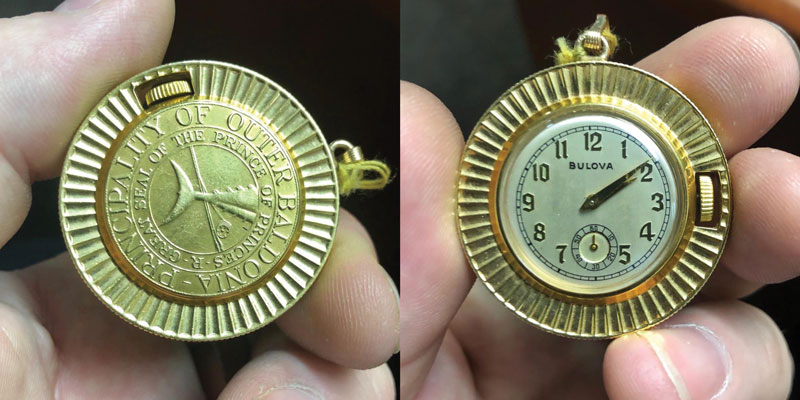 Russell Arundel’s friend Arde Bulova made a few gold Outer Baldonia pocket watches, which were shared with Arundel’s family. Images courtesy Arundel family
Russell Arundel’s friend Arde Bulova made a few gold Outer Baldonia pocket watches, which were shared with Arundel’s family. Images courtesy Arundel family
On the day of our trip, we convened at the pier in Wedgeport. We motored about an hour before sighting the island, with its lone stone cottage. With his mate’s help, LeBlanc put a Zodiac over the side and shepherded us ashore.
It began to rain as we made our way over washed-up bits of rope and other detritus on the shore, which included a seal carcass, and a gull or two. Tall grass hid divots that hampered our progress to the now-roofless stone cottage. My grandfather said sheep had once grazed on the island and I secretly wished they still did. Sally and I spotted a seagull on the chimney surveying our progress. “CayCay!” I said pointing.
From the hearth, under the crumbling “A” for Arundel built in stone, I looked out a picture window over the grey ocean and imagined what it was like back when CayCay was here. “You don’t get up, you stay up. By 5:30 in the morning you’re out fishing,” he told a reporter back in the day. “You have breakfast on the way out, usually lobster stew, and masses of coffee. You sit in the rip tide, and some of you hope you get a tuna, and some hope you don’t.”
Eventually, when the novelty wore off, my grandfather gave the island back to the birds and sheep, selling it to the Nova Scotia Bird Society for $1. It is now a bird breeding sanctuary.
It’s a tribute to the Canadian caretakers that ornithologist Currie spotted a number of birds during our brief visit. He saw Atlantic puffin and black guillemot fly from the beach on our approach. Along with the more common herring gulls and great black-backed gulls, he identified a breeding pair of Arctic terns. Savannah sparrows flitted over the tall grasses, and he was excited to discover a bank swallow, an endangered species, breeding in burrows on the upper cliff face.
Since returning home from Nova Scotia, I’ve wondered if the 29-year-old LeBlanc enjoyed our visit as much as we appreciated him. He wrote to me recently, “Meeting Wendy and Sally helped place a link between the large and sometimes embellished story of the micro-nation and today’s times. Many of the locals who have grown up near Outer Bald have approached me to tell me how great they thought it was that descendants of Mr. Arundel had made it to the area and made a modern connection with today’s fishermen.”
A link to the past and new friendships forged, my sister and I are still full from our adventure, still absorbing the spirit of the day and pondering the immortal nature of CayCay’s island folly.
As I have reflected, I’ve offered up a message to the spirit of the Prince of Princes, my CayCay who banned women from his island nation. Know this: Of your heirs, it was the Princesses, your intrepid granddaughters and great-granddaughters, who visited your unbelievable island in the north. First.
Wendy Arundel was a journalist for many years before discovering her current passion as a professional home organizer. While decluttering and creating systems with her clients, she teaches them the value of owning less and living more.
Related Articles
Share this article:
2023 Maine Boat & Home Show

Join Us for the Maine Boat & Home Show!
Art, Artisans, Food, Fun & Boats, Boats, Boats
August 11 - 13, 2023 | On the waterfront, Rockland, Maine
Click here to pre-order your tickets.
Show is produced by Maine Boats, Homes & Harbors magazine.















